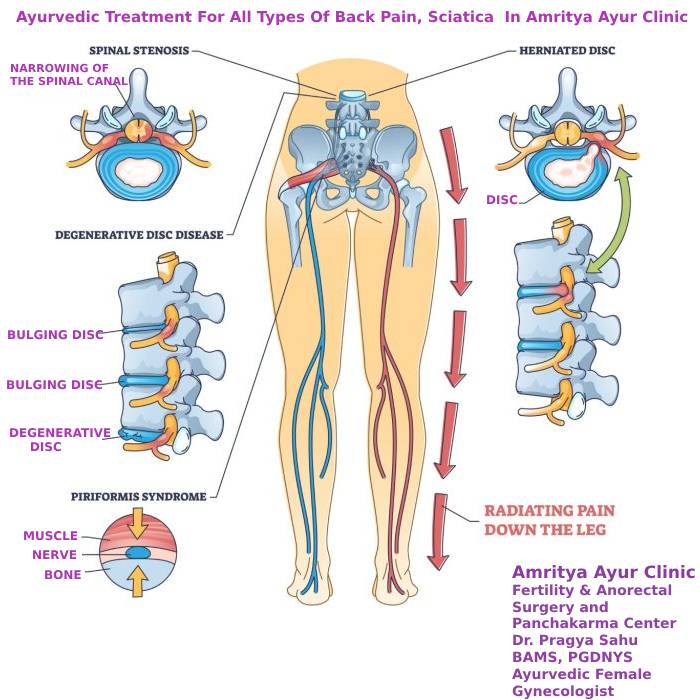Sciatica Pain Treatment
amrtiyaayuclinic@gmail.com
Dec 19, 2024 08:10 PM
In Ayurveda, Sciatica pain (known as Gridhrasi) and joint pain (referred to as Sandhi Vata or Vata-related joint disorders) are commonly treated using holistic approaches aimed at balancing the body's doshas (Vata, Pitta, and Kapha). These conditions often arise when there is an imbalance, especially in the Vata dosha, which governs movement, nervous system function, and bodily elimination.
Sciatica Pain (Gridhrasi)
Sciatica refers to pain that radiates along the sciatic nerve, which runs from the lower back through the hips and down each leg. In Ayurveda, Gridhrasi is linked to an imbalance in Vata dosha, which causes pain, numbness, and tingling, often exacerbated by sitting or moving.
Ayurvedic Treatment for Sciatica:
-
Herbal Remedies:
- Ashwagandha (Withania somnifera): Strengthens muscles and reduces inflammation.
- Guggulu (Commiphora wightii): Known for its anti-inflammatory properties and benefits in pain management.
- Brahmi (Bacopa monnieri): Helps to calm the nervous system and alleviate stress-related pain.
- Turmeric (Curcuma longa): A potent anti-inflammatory that can reduce pain and swelling.
-
Oil Massages (Abhyanga):
- Warm oils such as Mahanarayan oil, Sesame oil, or Ksheerabala oil are used for deep massage to alleviate Vata imbalances, soothe muscles, and reduce pain.
- The massage is performed with long strokes and gentle pressure, focusing on the lower back, hips, and legs.
-
Panchakarma Therapy:
- Basti (medicated enema): This is one of the most effective treatments for balancing Vata. It helps remove toxins from the colon and relieves pressure on the nerve roots.
- Swedana (sudation therapy): Herbal steam baths or sweating therapies are used to release toxins and improve circulation.
-
Dietary Guidelines:
- A Vata-pacifying diet that includes warm, moist, and grounding foods is recommended, such as soups, stews, and dairy products.
- Avoid dry, cold, and light foods that can aggravate Vata.
Joint Pain (Sandhi Vata)
Joint pain, particularly in the knees, hips, and elbows, can be caused by a Vata imbalance leading to dryness, stiffness, and inflammation. Ayurveda believes that the deterioration of the joints is primarily due to Vata dosha's cold, dry, and mobile qualities.
Ayurvedic Treatment for Joint Pain:
-
Herbal Remedies:
- Shallaki (Boswellia serrata): An anti-inflammatory herb that helps reduce joint pain and stiffness.
- Guggulu: Known for its effectiveness in joint pain and arthritis.
- Turmeric: Reduces swelling and inflammation in the joints.
- Nirgundi (Vitex negundo): An herb used to relieve joint pain and stiffness.
-
Oil Applications:
- Mahavishgarbha oil: A powerful oil for pain relief in joints, particularly when there is swelling and stiffness.
- Dhanwantharam oil: Commonly used for joint pain, especially in cases of arthritis.
- Kshirabala oil: This is often used for conditions involving joint and nerve pain.
-
Panchakarma Therapy:
- Abhyanga: Regular oil massage helps lubricate the joints and ease the pain.
- Kati Basti: Specifically for lower back pain, but it can be applied for any joint pain by focusing the therapy on the affected joint area.
- Udvartana: A powder massage, typically using herbal powders, to improve circulation and reduce stiffness.
-
Dietary Guidelines:
- Vata-pacifying foods: Warm, moist, and oily foods, such as soups, stews, and dairy products, to keep the joints lubricated.
- Avoid cold, dry, and raw foods that can further aggravate Vata and cause more pain in the joints.
-
Lifestyle Recommendations:
- Practice gentle exercises such as yoga and walking to improve joint mobility and reduce stiffness.
- Avoid excessive physical strain or prolonged periods of sitting or standing, which can increase the pressure on the joints.
Conclusion:
In Ayurveda, the treatment of sciatica and joint pain focuses on balancing Vata dosha, soothing the nervous system, improving circulation, and reducing inflammation. A combination of herbal remedies, oil therapies, Panchakarma treatments, and dietary adjustments can help manage and alleviate these painful conditions. However, it’s essential to consult with a qualified Ayurvedic practitioner for personalized advice based on your unique constitution (Prakriti) and current state of health (Vikriti). Amritya Ayur Clinic,
